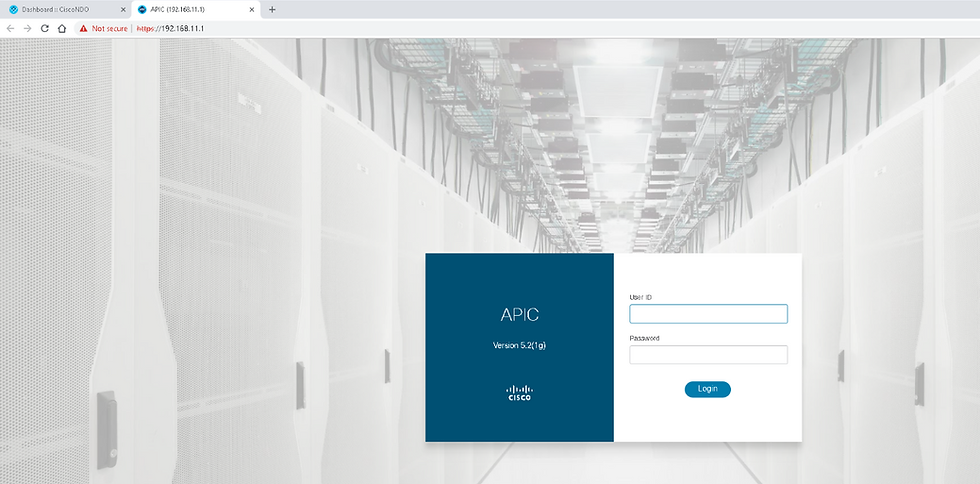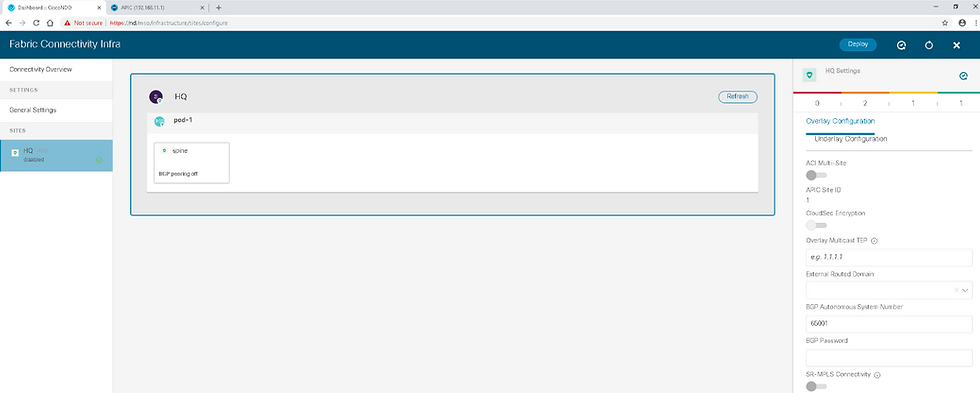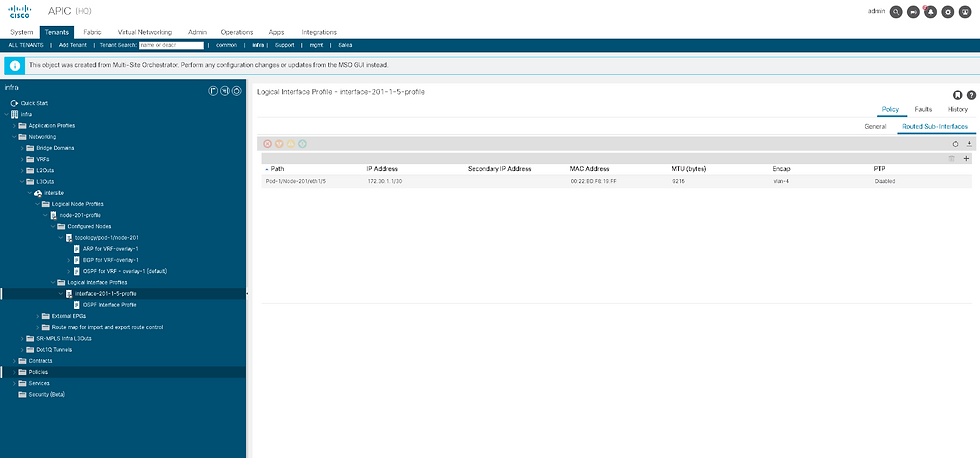Nexus Dashboard Orchestrator
- Mukesh Chanderia

- May 16, 2024
- 6 min read
Updated: Jul 3, 2024
Step 1: Log into ND
click --> ok
Step 2: Go to Dashboard it will take you to One View display
Step 3: Go to Admin Console
Step 4: configure a route for the out-of-band access to your site.
Go to Infrastructure >Cluster Configuration. In the Routes area, click Edit (the pencil symbol), choose Add Management Network Routes, enter 192.168.11.0/24, confirm it, and click Save.
Log in putty in ND and you must see management route
Step 5: Add Site
Click on site
Add site
Step 6: Go to Services and open the Nexus Dashboard Orchestrator.
Step 7: In the Orchestrator, go to Infrastructure > Sites. Set the state of the HQ site to Managed. Configure the Site ID 1 and click Add.
Step 8: Refresh the page, click the three dots on the right (details symbol) and choose Import Tenants. Choose the tenant Sales and click OK
A schema is used to push a policy to multiple sites. Having imported the tenant Sales, you have not imported its sub-policies. In this scenario, you will create another tenant Support, define several sub-policies, and push the new tenant to the site.
Schema contains Templates & displays tenants associated with it.
A Template can be associated to one or more site
Schema you first need to select tenants & then App Profile, EPG, VRF, BD and contract, filter & External EPG.
Any policy change made to template will always be applied and pushed at one time to all the sites associated with template.
So, if you want to stretch VRF but not BD you need different template
Template 1: VRF pushed to both site
Template 2: BD – subnet pushed to site 1 only
Template 3: BD – subnet Pushed to site 2 only
Step 9: Go to Application Management > Tenants,
Step 10: Tenants, click Add Tenant, set the display name to Support, make sure it is associated with site HQ and click Save.
Step 11: Go to Application Management >Schemas, click Add schema, enter its name Support-Schema and click Add.
Step 12: In the TEMPLATES menu, click the Add symbol, set the template type to ACI Multi-cloud and click Add.
Step 13: In the right pane, set the Display Name to Support-Template and select tenant Support.
Step 14: In the middle pane, hover your mouse over Application profile and click Add Application Profile.
In the right pane, enter the display name Support_AP.
Step 15: Hover your mouse over EPGs and click Add EPG. In the right pane, enter Front_EPG as the display name for the EPG.
Step 16: Hover your mouse over VRFs and click Add VRF. Set the display name to Support_VRF.
Later, when you push the template to your site, you will see that the display names actually become the object names.
Step 17: Hover your mouse over Bridge Domains and click Add Bridge Domain. Set the display name to Support_BD.Select Support_VRF from the Virtual Routing & Forwarding drop-down list.
Step 18: Click the Front_EPG and select Support_BD from the Bridge Domain drop-down in the right pane & click "Save"
Step 19: In the navigation pane, click + in the SITES menu. Check HQ, choose the Support-Template and click Save.
Step 20: In the top-right corner, click Save. In the middle pane, click Deploy to sites. Then click Deploy and close schema configuration page.
Step 21: Go to Infrastructure > Sites, open the HQ details by clicking on the three dots and choose Open in APIC user interface.
In a nearby tab APIC GUI will open
Step 22: Check the Tenant "Support" has been provisioned with MSO
Configure Fabric Connectivity Infra
Step 23: Return to the Orchestrator, go to Infrastructure > Infra Configuration and choose Configure Infra.
Step 24 : Review the parameters in General Settings > Control Plane BGP.
Default is full-mesh but can be configured as "route-reflector"
Step 25: General Settings > IPN Devices.
Step 26 : Choose the HQ site in the navigation pane and the click outer square in the middle pane, containing site-level settings. In the right pane, in Overlay Configuration, click the ACI Multi-Site knob to enable the site for Multi-Site connectivity and configure these settings:
Overlay Multicast TEP: 10.10.10.10
External Routed Domain: ExtL3Dom
The BGP AS number is the same one as MP-BGP AS and is automatically pulled from the Cisco APIC.
The Overlay Multicast TEP is used as the outer IP for VXLAN encapsulation when another site sends a flood traffic towards this site. When this site receives the packet with this outer IP, it will treat it as flooding traffic. Hence, the Overlay Multicast TEP itself should be a unicast IP address that is routable within ISN.
Step 27 : In the right pane, choose Underlay Configuration and configure the following settings:
OSPF Area ID: 1
OSPF Area Type: regular
Open Shortest Path First (OSPF) is to establish an OSPF session with the ISN device, which needs to be manually configured. OSPF is used to advertise the Overlay Multicast TEP to the ISN.
Step 28 : Select pod-1 (intermediate square in the middle pane) and set the Overlay Unicast TEP to 192.168.50.1
Overlay Unicast TEP is used as the outer IP for VXLAN encapsulation when another site sends a unicast traffic to this pod in this site. Each pod needs a specific Overlay Unicast TEP IP address.
Step 29 :
Select spine (inner square in the middle pane), click Add Port and enter these parameters for the OSPF spine peering. Click Save.
Ethernet Port ID: 1/5
IP Address: 172.30.1.1/30
MTU: 9216
OSPF Policy: msc-ospf-policy-default
OSPF Authentication: none
Within the spine settings, click the BGP peering knob to enable BGP-EVPN and set the BGP-EVPN router ID to 10.7.7.7. Click Deploy in the top task bar.
Step 30 : Go to the Cisco APIC user interface, navigate to Tenants > infra > Networking > L3Outs. Expand the L3Out intersite and examine its sub-elements.
Note : The switch profile and spine interface profile for this Multi-Site configuration have not been automatically added to the external domain ExtL3Dom. In production environments, configure those policies to keep the fabric fault-free.
Step 31 : Within the infra tenant, go to Policies > Protocol > Fabric Ext Connection Policies > Fabric Ext Connection Policy and briefly examine the policy.
A pod connection profile "1" has been provisioned. Other specific options, such as fabric external routing profiles have not been pushed. This validation completes the lab exercise.
ACI Multi-Site and L3Out Shared GOLF L3Out.
GOLF configuration (‘infra’ tenant L3Out) performed on APIC.
Tenant L3Outs locally provisioned on each site’s APIC
Multi-Site associates Golf L3Out from each site with App OpenCart
Multisite Translation Requirements
In a typical APIC multisite environment, a particular site may expose certain services which other sites may desire to consume.
An example would be a shared DNS service provided by one of the sites which other sites want to use.
The other common use case is to allow peer-to-peer communication between a pair of EPgs across sites.
pod36-leaf1# show system internal epm endpoint ip 172.16.2.2
MAC : 0050.56b1.4403 ::: Num IPs : 1
IP# 0 : 172.16.2.2 ::: IP# 0 flags :
Vlan id : 21 ::: Vlan vnid : 8194 ::: VRF name : DC:DC1
BD vnid : 16220082 ::: VRF vnid : 2457600
Phy If : 0x1a001000 ::: Tunnel If : 0
Interface : Ethernet1/2
Flags : 0x80004c04 ::: sclass : 32771 ::: Ref count : 5
EP Create Timestamp : 04/19/2018 07:03:23.999543
EP Update Timestamp : 05/02/2018 02:33:29.507208
EP Flags : local|IP|MAC|sclass|timer|
pod36-spine1# show coop internal info ip-db key 2457600 172.16.2.2 : <-- local site
IP address : 172.16.2.2
Vrf : 2457600
Flags : 0
EP bd vnid : 16220082
EP mac : 00:50:56:B1:44:03
Publisher Id : 10.1.48.64
Record timestamp : 05 02 2018 02:29:12 339899902
Publish timestamp : 05 02 2018 02:29:12 340145880
Seq No: 0
Remote publish timestamp: 01 01 1970 00:00:00 0
URIB Tunnel Info
Num tunnels : 1
pod35-spine1# show coop internal info ip-db | egrep -A 15 -B 1 "172.16.2.2$" <-- Remote Site
------------------------------
IP address : 172.16.2.2
Vrf : 3014656
Flags : 0x4
EP bd vnid : 15925206
EP mac : 00:50:56:B1:44:03
Publisher Id : 10.10.35.102
Record timestamp : 01 01 1970 00:00:00 0
Publish timestamp : 01 01 1970 00:00:00 0
Seq No: 0
Remote publish timestamp: 04 24 2018 05:05:34 611613733
URIB Tunnel Info
Num tunnels : 1
Tunnel address : 10.10.35.102
Tunnel ref count : 1
Tunnel address : 10.1.48.64
Tunnel ref count : 1
















































Comments